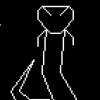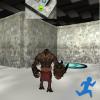Many years ago I made a small "game", there was 20x20 map and up to 100 creatures (it was an ancient computer so the performance was an issue :)). These creatures were moving around the map (completely random) and breed or eat grass. Each grid had certain amount of grass (which increased/regrow each turn), the creatures had "chewing" stat which determined how much they could devour per turn. There were also other stats like "breeding cost" (how much food is required to give birth to an offspring), "max age" (after how many turns the creature will die), "virus resistance" (if you pressed 'v' key, there was a disease and all creatures that failed virus resist check died instantly), "temperature resistance" (if you pressed 't' key, there was a solar flare and all creatures that failed temperature resist check died instantly). When two creatures (of any kind, there was no gender) meet they could produce an offspring (using up stored/digested food). The new creature had average of all stats of both parents +/- 1 (mutation).
I observed many fascinating things (like the breeding cost increasing when I did a lot of disasters - under peaceful conditions the breeding cost and max age were the stats that were going up), note that there was no algorithm or AI of any kind, just pure probability that driven the artificial evolution. I was mesmerized by it.
Generally, not much of a game, nothing to do and overall boring. But... Somehow I enjoyed it. More watching than playing (end turn, inspect a creature, look at the map (full of 8x8 pixel almost identical icons), v/t key for a disaster; and that's all).
I wonder, is this idea worth pursuing? Is it worth trying to make a small game with this premise (generally, there is no problem making it more rich and complex, but the player's input would still be low)?











